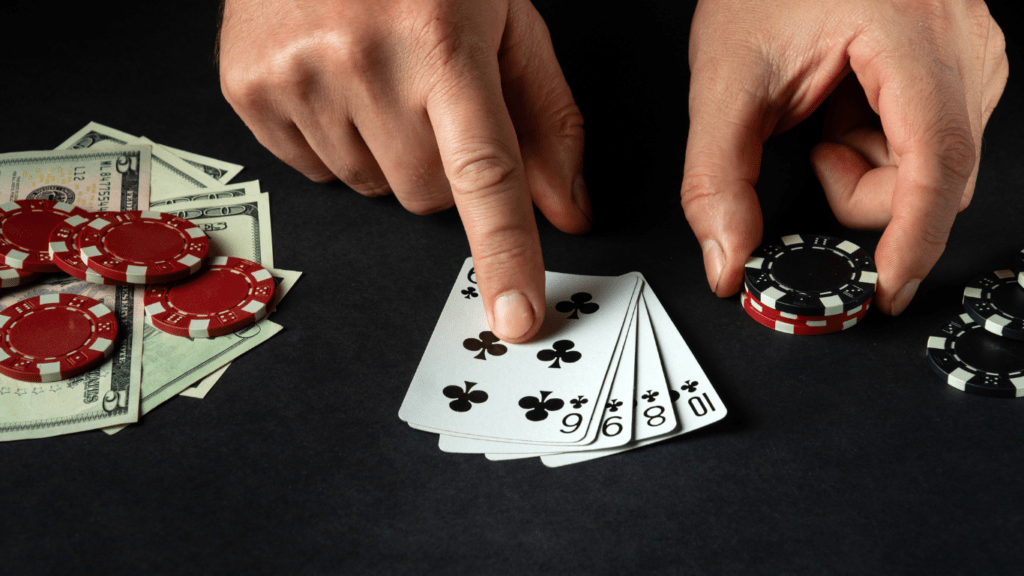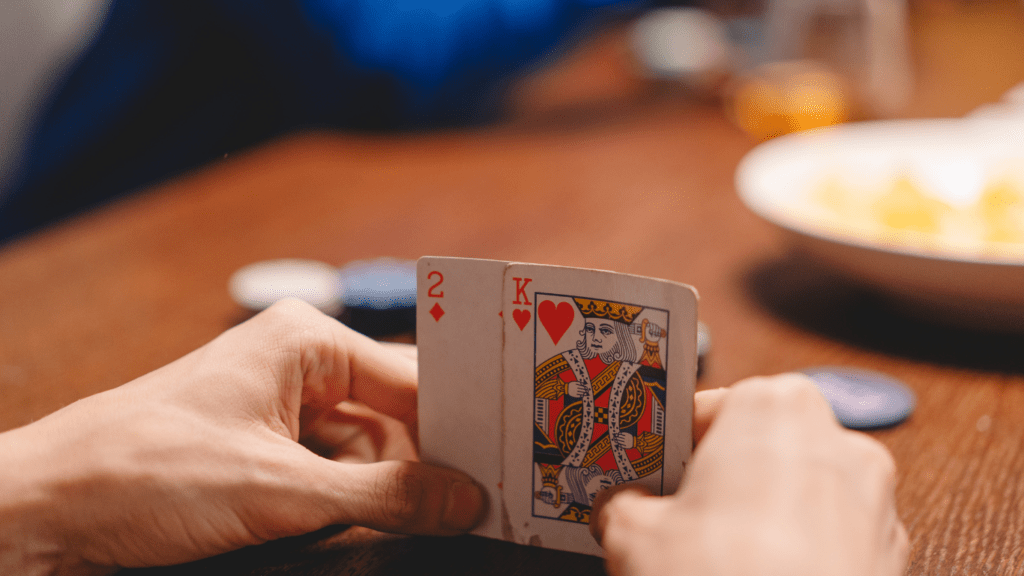Understanding The Concept of Bluffing
Bluffing in poker means making others believe you have a stronger or weaker hand than you actually hold. It’s an essential tool in poker strategy. Mastering the concept involves grasping when and why to bluff, not just how.
Effective bluffing hinges on a few key factors:
- Table Image: This refers to how other players perceive you. A tight player (one who bets conservatively) is more likely to succeed in bluffing compared to a loose player (one who bets aggressively). For example, if you’ve been folding for several hands and suddenly raise big, opponents might believe you’ve got strong cards.
- Opponent’s Behavior: Reading other players is crucial. Timing your bluff against players who are hesitant or those who don’t call frequently can increase success. Observing betting patterns helps identify who are the “calling stations” (players who call frequently, making bluffing against them unwise).
- Bet Sizing: The amount bet should match the narrative you’re creating. Small bets often seem weak, while overbets can appear desperate or overly strong. For instance, a half-pot bet on a dry board (one with no potential for straight or flush) might convince opponents you’ve got a made hand.
- Position: Being in a late position (near the dealer button) provides more information about other players’ actions, allowing for better bluffing decisions. If everyone checks, betting can effectively portray strength since those before opted not to bet.
- Community Cards: The shared cards on the table impact bluffing decisions. Bluffing on a board that favors your perceived range (e.g., high cards if you’re an aggressive player) is more credible than bluffing on a completely disconnected one.
Understanding these aspects allows the creation of a plausible storyline around the bluff. It’s not just about the poker face, but the entire act—bets, timing, position, and the cards on the table working in concert. This psychological manipulation is what makes bluffing a powerful tool in poker.
Key Elements of a Successful Bluff
Bluffing in poker requires a combination of observation, strategy, and execution. Critical factors ensure that a bluff appears credible and effective.
Reading Opponents
Understanding opponents’ behavior is crucial in bluffing. I watch for patterns and tendencies like aggressiveness during specific hands or passivity in others. If a player folds frequently, bluffing them is more likely to succeed. Conversely, an opponent who calls every bet might see through the bluff. I use observations to tailor my strategy, making it harder for opponents to predict my moves.
Timing Your Bluff
Effective bluffing depends heavily on timing. I consider situational factors such as the number of players in the hand and the actions leading up to my bluff. Bluffing against multiple opponents reduces its success rate. Instead, I bluff in scenarios where I’m against one or two players. Additionally, I avoid frequent bluffs within a short period, making my bluffs more believable when they occur.
Consistency and Frequency
Maintaining consistency in my overall gameplay helps my bluffs appear genuine. If my actions suddenly differ from my usual pattern, opponents might suspect a bluff. Therefore, I keep my bet sizing, timing, and behavior consistent. However, I balance this with bluff frequency; bluffing too often can lead to being caught, while not bluffing enough misses opportunities. I aim for a balanced approach that keeps my opponents guessing.
Techniques to Bluff Successfully

Bluffing in poker requires strategic thought and execution. There are various techniques to make your bluffs more convincing and effective.
Semi-Bluffing
Semi-bluffing involves betting or raising with a mediocre hand that has the potential to improve. For instance, when holding a drawing hand like a flush draw, I might place a strong bet. This way, even if my hand isn’t strong at the moment, there’s a chance it can become strong by the turn or river cards. Semi-bluffs work because they combine the threat of having a good hand with the possibility of improving to a winning hand.
Stone Cold Bluffing
Stone cold bluffing means betting or raising with a weak hand that has minimal chance of improving. When I execute a stone cold bluff, I rely entirely on my ability to convince my opponent that I have a strong hand. Timing and table image are crucial here. If opponents perceive me as a tight, conservative player, my stone cold bluffs are more likely to succeed. However, I must be cautious because if called, I’ll lose the pot with a weak hand.
Continuation Bets
A continuation bet, or c-bet, is a follow-up bet made after raising pre-flop and being the first to act post-flop. The idea is to maintain pressure and show strength, even if the flop didn’t improve my hand. For example, if I raised pre-flop with Ace-King and the flop comes 7-9-2, a continuation bet makes my opponents believe I still have a strong hand. Effective use of c-bets keeps opponents guessing about the strength of my hand while taking control of the table dynamic.
Common Mistakes to Avoid
Successfully bluffing in poker requires more than just a good poker face. Common pitfalls can derail your game if you’re not careful.
Over-Bluffing
Over-bluffing can quickly become a problem. If I bluff too frequently, opponents catch on and call my bets more often. Skilled players look for patterns, so mix up your strategy. Bluff selectively, ensuring each bluff adds to the narrative you’re building.
Examples:
- Bluffs on every other hand will make you predictable.
- Bluffing in low-stakes games where players call often is usually ineffective.
Bluffing Against The Wrong Players
Choose your targets wisely. Bluffing against novice players or those notorious for calling often backfires. These players prefer seeing the showdown, making your bluffs less effective. When bluffing, aim for more experienced players who can fold stronger hands based on the board and bet size.
Examples:
- Bluffing a novice who calls down with any pair is inefficient.
- Targeting tight players who fold under pressure pays off more.
Ignoring Table Dynamics
Paying attention to table dynamics is crucial. If I ignore previous betting actions, community cards, and opponents’ tendencies, my bluffs lose credibility. Adapt your strategy to the game’s flow and the players’ tendencies. Recognize different phases of the game and adjust your approach accordingly.
Examples:
- Bluffing right after a significant loss on your part may be seen as desperate.
- Attempting a major bluff after consecutive hands with heavy action can undermine your position.
Avoid these common mistakes to increase your success rate and keep opponents guessing.
Enhancing Your Bluffing Skills
Improving bluffing skills requires practice, studying pros, and analyzing personal gameplay. By focusing on these strategies, you can master the art of bluffing and become a formidable player.
Practice and Experience
Practice sharpens skills. Regularly playing poker helps identify patterns and recognize bluffing opportunities. Tracking results of bluffs, noting what works and what doesn’t, builds invaluable experience. The more hands played, the better the understanding of various game dynamics, such as when opponents are likely to fold under pressure. Through continual practice, adapting strategies becomes second nature.
Studying Pro Players
Learning from the pros offers invaluable insights. Watching professional poker tournaments showcases how top players execute bluffs. Analyzing televised games or online streams reveals their thought processes, bet sizing, and timing. Poker training sites and videos often break down these strategies in detail. By emulating these techniques and understanding the reasoning behind them, I can incorporate similar tactics into my gameplay.
Analyzing Your Own Moves
Self-analysis is crucial for improvement. Reviewing past games, whether through hand histories or recording sessions, identifies mistakes and successes in bluffing. Noting specific situations where my bluffs worked or failed helps refine my approach. Using poker software tools can also provide statistical feedback on my bluffing patterns. Regularly evaluating my gameplay leads to consistent growth and better decision-making.
Incorporating these practices enhances bluffing effectiveness. With dedication to practice, learning from experts, and continuous self-review, I can turn bluffing into a powerful weapon in my poker arsenal.


 Pedro Brandon played a crucial role in developing the content strategy for Bet Roll Gamble, ensuring the platform offers timely, accurate, and engaging insights across sports betting, poker, horse racing, and esports. His ability to identify trends and curate relevant content has helped attract a diverse audience, providing bettors with the strategies and updates they need to stay competitive.
Pedro Brandon played a crucial role in developing the content strategy for Bet Roll Gamble, ensuring the platform offers timely, accurate, and engaging insights across sports betting, poker, horse racing, and esports. His ability to identify trends and curate relevant content has helped attract a diverse audience, providing bettors with the strategies and updates they need to stay competitive.